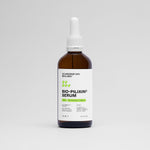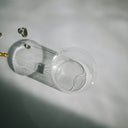Hair dye is a popular choice for individuals looking to change their appearance, enhance their natural color, or cover gray hair. With its widespread use, many people have raised concerns about the potential side effects of hair dye, particularly regarding hair loss. This article will explore the relationship between hair dye and hair loss, addressing common concerns and providing insights on how to safely use hair dye without harming your hair.
Table of content
Does hair dye cause hair loss?
No, hair dye does not directly cause hair loss. However, certain chemicals in hair dyes can lead to hair damage, which may contribute to hair breakage and an overall decrease in hair health. When hair is damaged due to chemical processes, it can become weak and more prone to breaking, leading to a thinner appearance. It's important to differentiate between hair loss (which involves hair shedding from the scalp) and hair breakage (which occurs along the hair shaft).
Many commercial hair dyes contain ammonia, peroxide, and other harsh chemicals that can strip the hair of its natural moisture and proteins. This damage can weaken the hair structure, making it more susceptible to breakage. Furthermore, improper application of hair dye, such as leaving it on for too long or not following the instructions, can exacerbate these issues.
As your leading source for hair health information over the past 4 years, we never compromise on accuracy. When it comes to your health, you deserve information you can truly rely on - and earning your trust is our top priority.
Here's how Scandinavian Biolabs ensures every piece of content meets the highest standards of accuracy and integrity:
- Credentialed Experts: Our reviewers are actively practicing doctors and medical researchers
- Stringent Reviews: Content undergoes rigorous editing by subject specialists and review by a practicing doctor.
- Evidence-Based: We rely on well-established research from trusted scientific sources like peer-reviewed journals and health authorities.
- Full Transparency: Our editorial standards, writer credentials, reviewer credentials, correction process, and funding are all publicly documented.
- Independent Voice: While we do promote products, we operate in a vacuum to business operations. Our main goal is just an unwavering commitment to providing medically-sound guidance.
You can count on Scandinavian Biolabs to consistently deliver the trustworthy health information you deserve. Read our Editorial Standards.
Understanding Hair Types and Sensitivities
Everyone's hair is unique, and some individuals may have more sensitive hair or scalps than others. Those with fine or damaged hair may experience more noticeable effects from hair dye, including breakage or irritation of the scalp. If you have previously experienced allergic reactions to hair products, it is essential to conduct a patch test before applying the dye to your entire head. This can help identify any adverse reactions that could lead to further hair and scalp issues.
Choosing the Right Hair Dye
When considering hair dye, opting for products that are free from harsh chemicals can significantly reduce the risk of hair damage. Look for dyes labeled as ammonia-free, peroxide-free, and those that contain nourishing ingredients such as oils and botanical extracts. These types of hair dyes are gentler on your hair and can help maintain its health while still providing desired color results.
Tips for Healthy Hair Dyeing
To minimize the risk of hair damage and maintain healthy hair while dyeing, consider the following tips:
- Conduct a patch test: Always perform a patch test to check for allergic reactions before using a new hair dye.
- Follow instructions: Adhere to the instructions provided with the hair dye to avoid over-processing the hair.
- Deep condition: Use a deep conditioning treatment before and after dyeing to help restore moisture and strength to your hair.
- Limit frequency: Avoid dyeing your hair too often. Allow time for your hair to recover between colorings.
- Consult a professional: If you are unsure about dyeing your hair yourself, consider consulting a professional stylist who can help achieve the desired results with minimal damage.
Alternatives to Traditional Hair Dye
If you're concerned about the potential effects of traditional hair dyes, there are alternative options available that can provide color without the same level of chemical exposure. Natural dyes, such as henna, indigo, or coffee, can offer temporary color without harsh chemicals. These options may not provide the same vibrant results as traditional dyes, but they can be a safer choice for those with sensitive hair or scalps.
Signs of Hair Damage
It’s crucial to recognize the signs of hair damage, especially if you frequently dye your hair. Look for the following indicators:
- Excessive dryness or brittleness
- Split ends and frizz
- Unusual hair breakage
- Loss of shine and softness
If you notice any of these signs, it may be time to give your hair a break from dyeing and focus on restoring its health.
Conclusion
While hair dye does not directly cause hair loss, the chemicals used in many hair dyes can lead to hair damage that may contribute to breakage. To protect your hair's health, choose gentler products, follow the application instructions carefully, and prioritize hair care before and after dyeing. By being mindful of your hair's needs and opting for safer alternatives, you can enjoy vibrant hair color without compromising your hair's integrity.
Tired of Thinning Hair? Try a Clinically Tested Serum.
Looking for a natural way to regrow hair and achieve a thicker, fuller head of hair? Ditch the stinging nettle for hair loss – Bio-Pilixin Serum is a drug-free hair activation serum that delivers clinically tested results.
Here's why Bio-Pilixin is superior:
- Clinically Tested Results: 93% of users saw a reduction in hair loss, and 73% experienced increased hair density.
- Safe and Natural: Unlike harsh chemicals, Bio-Pilixin uses plant growth factors derived from stem cell technology to nourish hair follicles and stimulate growth.
- Fast-Acting: See visible results in as little as 45 days (most typically see results within 150 days).
Stop wasting time on unproven remedies. Bio-Pilixin is the safe, natural serum you've been searching for.
Read more:






